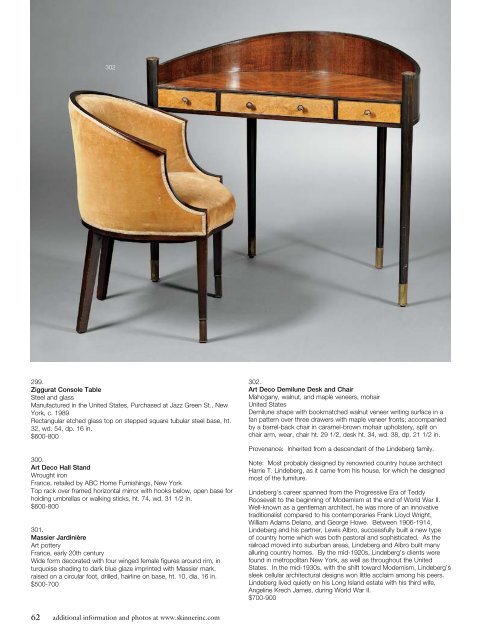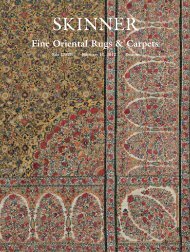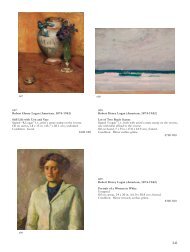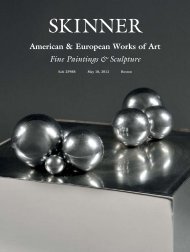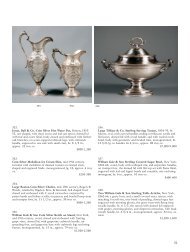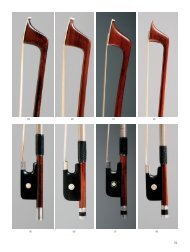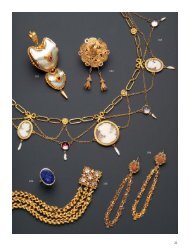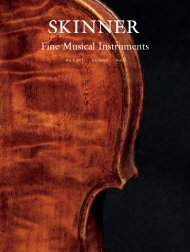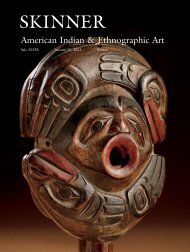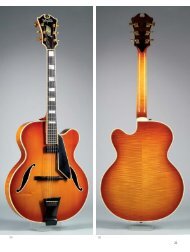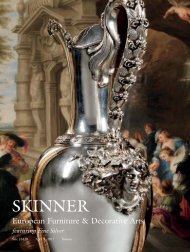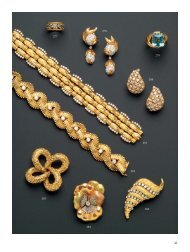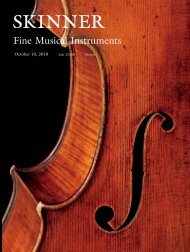SKINNER
SKINNER
SKINNER
You also want an ePaper? Increase the reach of your titles
YUMPU automatically turns print PDFs into web optimized ePapers that Google loves.
302<br />
299.<br />
Ziggurat Console Table<br />
Steel and glass<br />
Manufactured in the United States, Purchased at Jazz Green St., New<br />
York, c. 1989<br />
Rectangular etched glass top on stepped square tubular steel base, ht.<br />
32, wd. 54, dp. 16 in.<br />
$600-800<br />
300.<br />
Art Deco Hall Stand<br />
Wrought iron<br />
France, retailed by ABC Home Furnishings, New York<br />
Top rack over framed horizontal mirror with hooks below, open base for<br />
holding umbrellas or walking sticks, ht. 74, wd. 31 1/2 in.<br />
$600-800<br />
301.<br />
Massier Jardinière<br />
Art pottery<br />
France, early 20th century<br />
Wide form decorated with four winged female figures around rim, in<br />
turquoise shading to dark blue glaze imprinted with Massier mark,<br />
raised on a circular foot, drilled, hairline on base, ht. 10, dia. 16 in.<br />
$500-700<br />
302.<br />
Art Deco Demilune Desk and Chair<br />
Mahogany, walnut, and maple veneers, mohair<br />
United States<br />
Demilune shape with bookmatched walnut veneer writing surface in a<br />
fan pattern over three drawers with maple veneer fronts; accompanied<br />
by a barrel-back chair in caramel-brown mohair upholstery, split on<br />
chair arm, wear, chair ht. 29 1/2, desk ht. 34, wd. 38, dp. 21 1/2 in.<br />
Provenance: Inherited from a descendant of the Lindeberg family.<br />
Note: Most probably designed by renowned country house architect<br />
Harrie T. Lindeberg, as it came from his house, for which he designed<br />
most of the furniture.<br />
Lindeberg’s career spanned from the Progressive Era of Teddy<br />
Roosevelt to the beginning of Modernism at the end of World War II.<br />
Well-known as a gentleman architect, he was more of an innovative<br />
traditionalist compared to his contemporaries Frank Lloyd Wright,<br />
William Adams Delano, and George Howe. Between 1906-1914,<br />
Lindeberg and his partner, Lewis Albro, successfully built a new type<br />
of country home which was both pastoral and sophisticated. As the<br />
railroad moved into suburban areas, Lindeberg and Albro built many<br />
alluring country homes. By the mid-1920s, Lindeberg’s clients were<br />
found in metropolitan New York, as well as throughout the United<br />
States. In the mid-1930s, with the shift toward Modernism, Lindeberg’s<br />
sleek cellular architectural designs won little acclaim among his peers.<br />
Lindeberg lived quietly on his Long Island estate with his third wife,<br />
Angeline Krech James, during World War II.<br />
$700-900<br />
62 additional information and photos at www.skinnerinc.com


